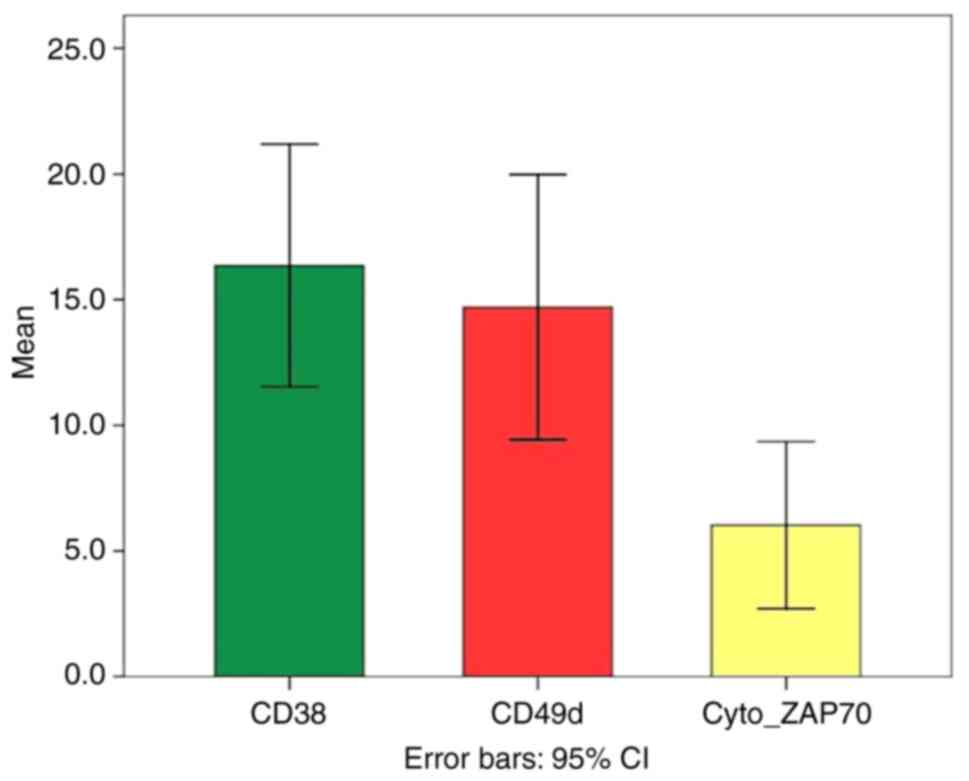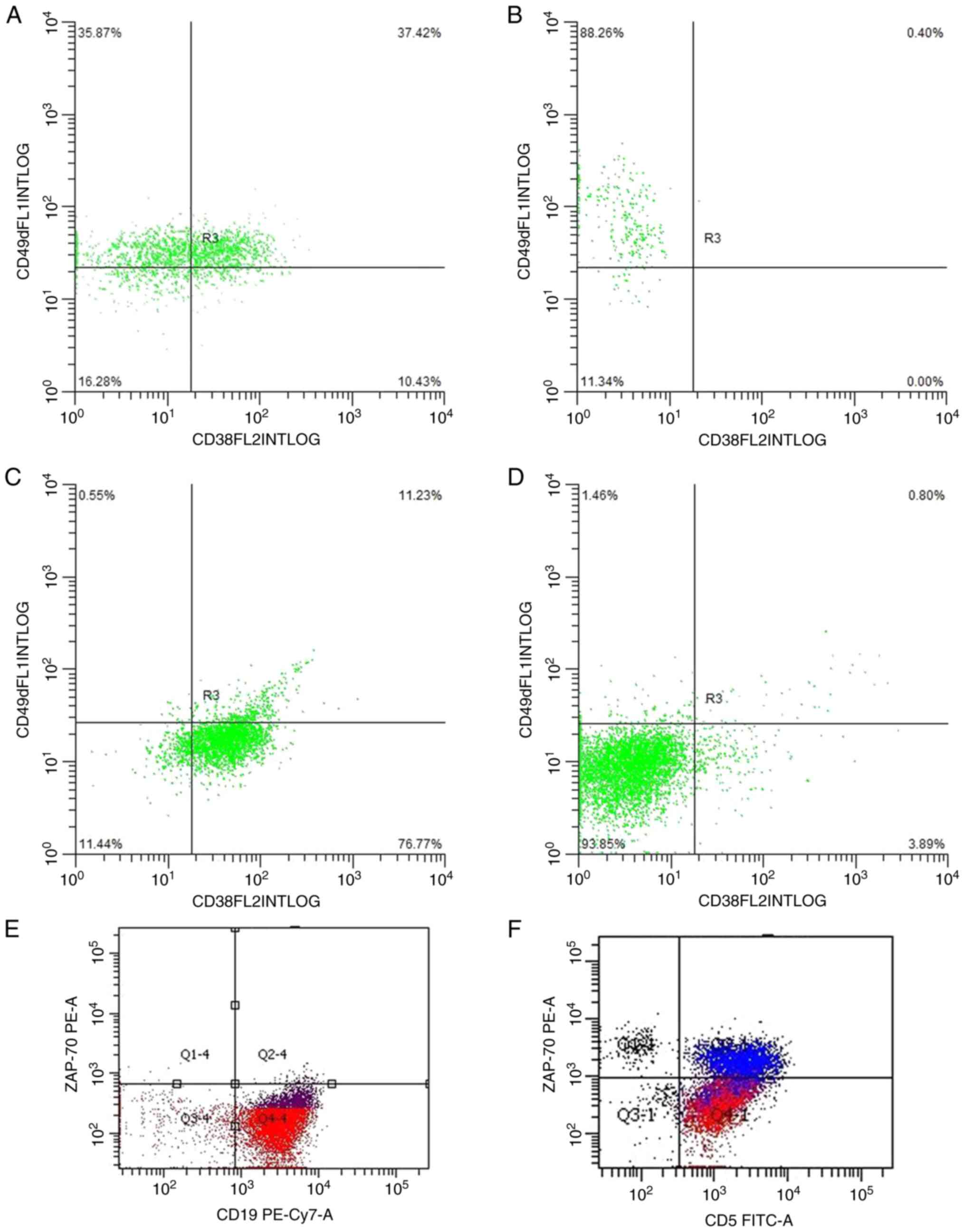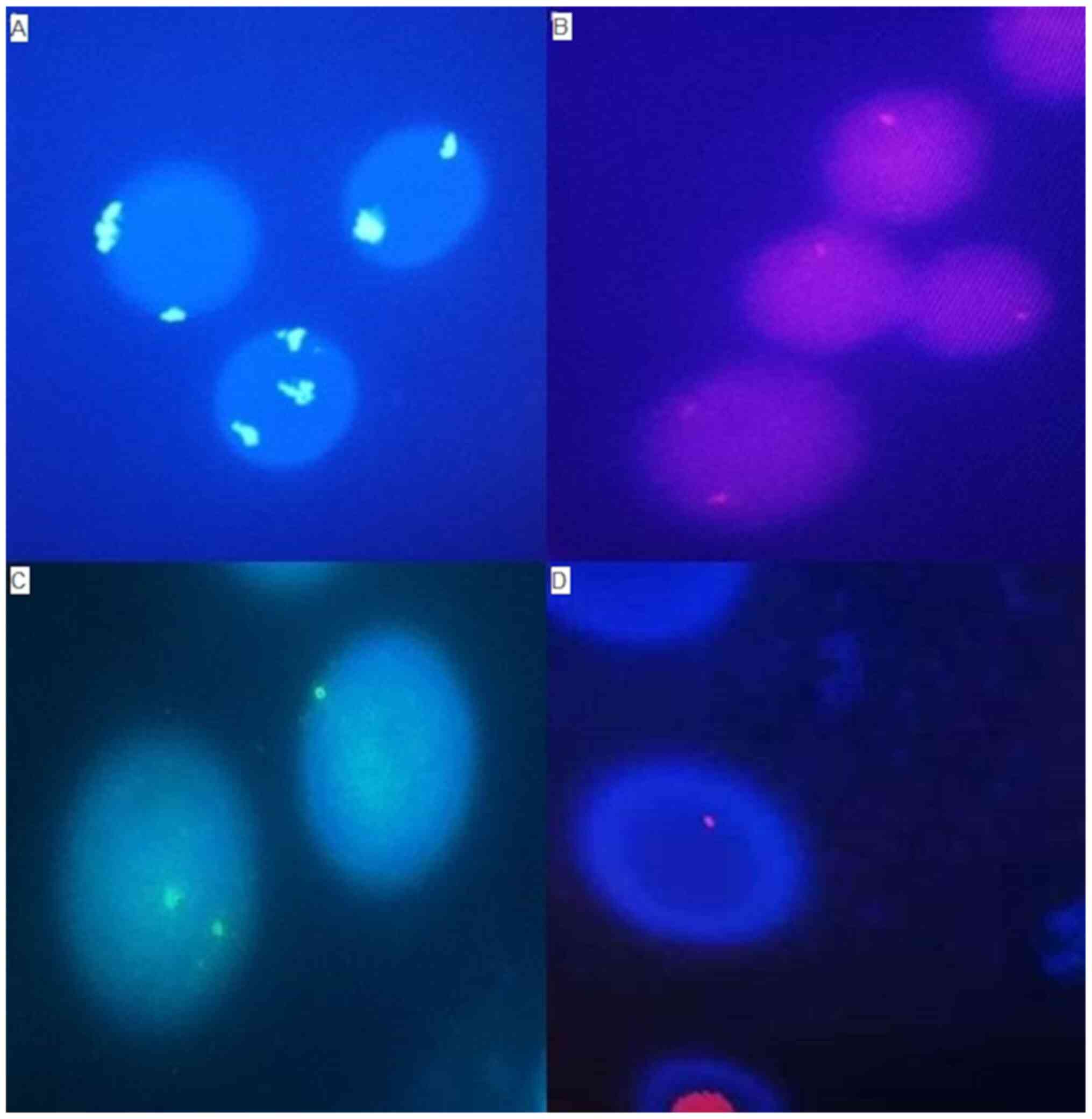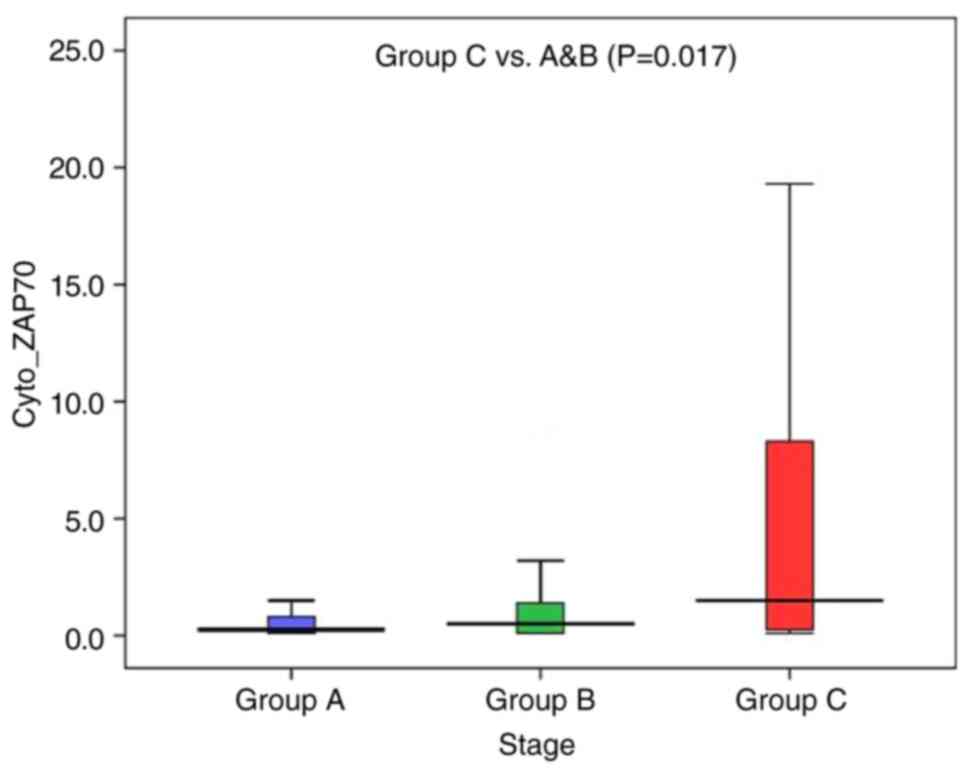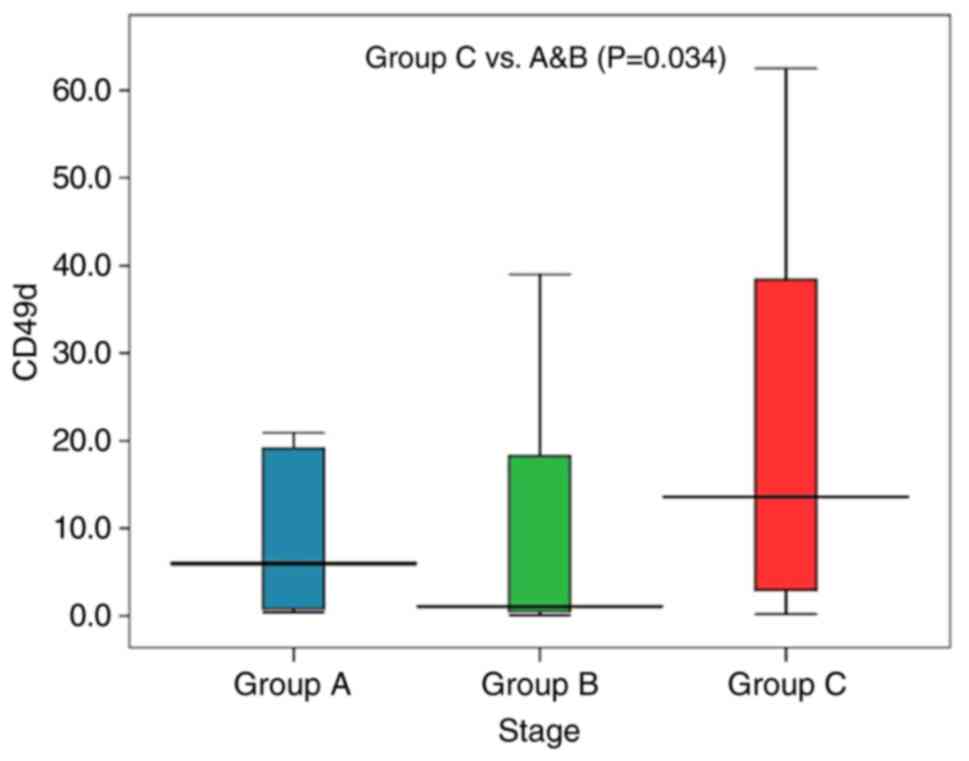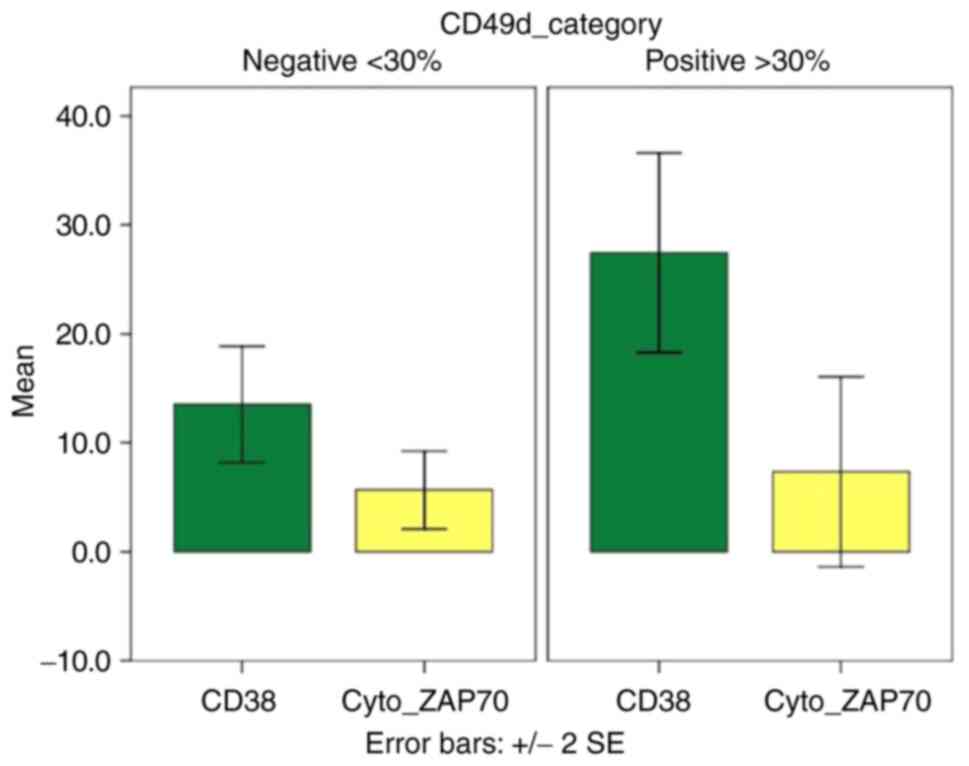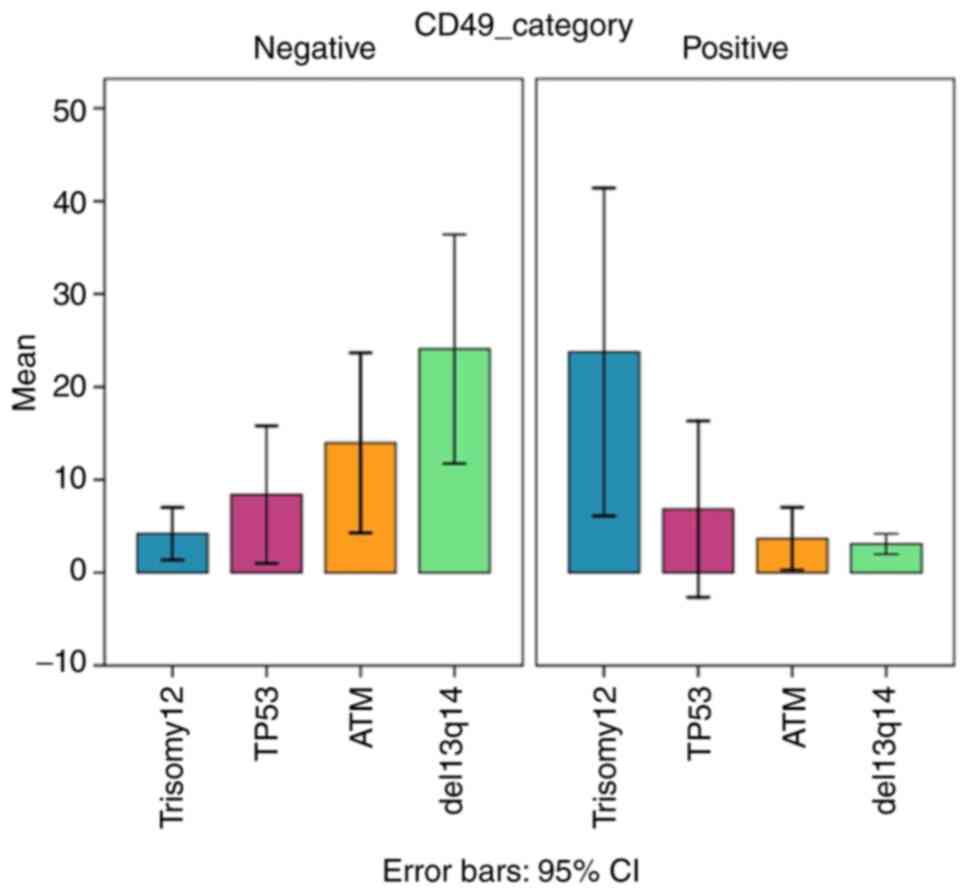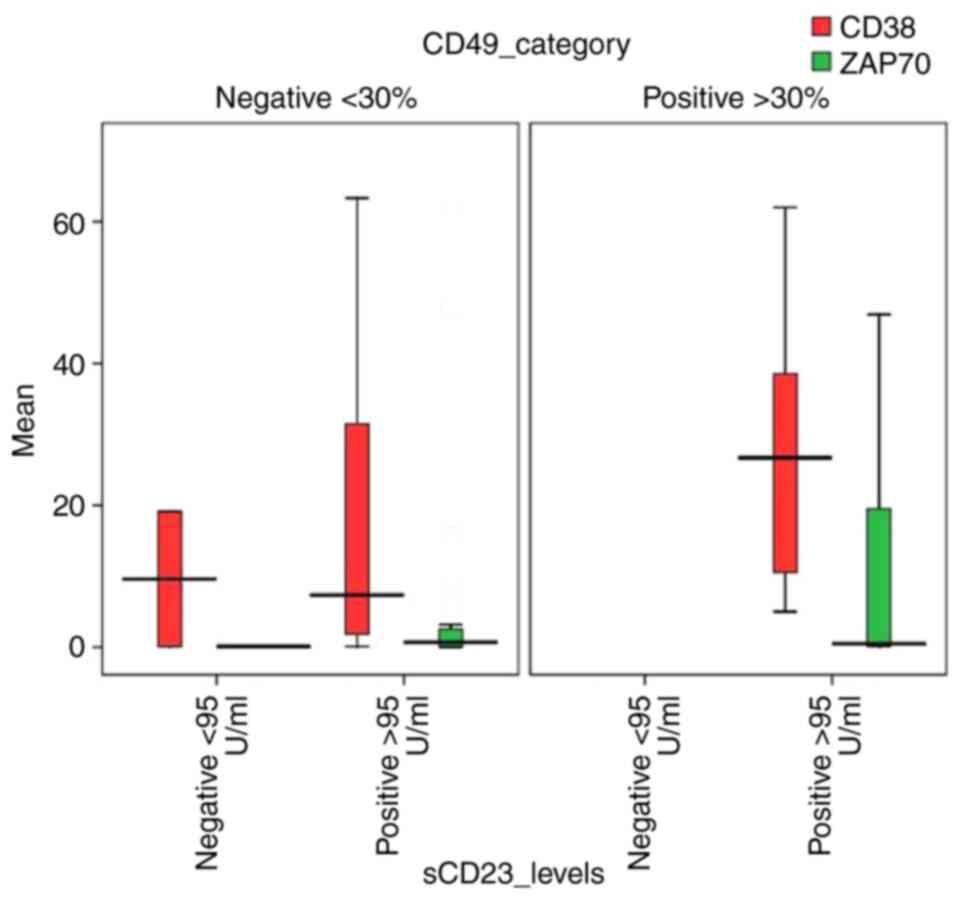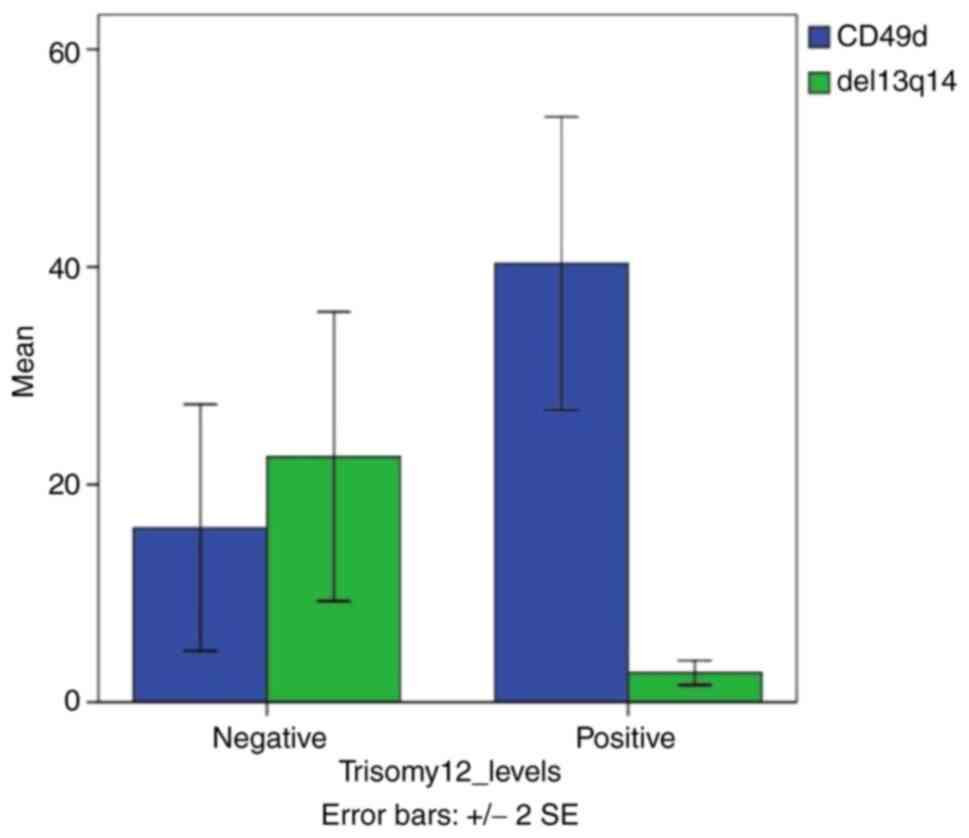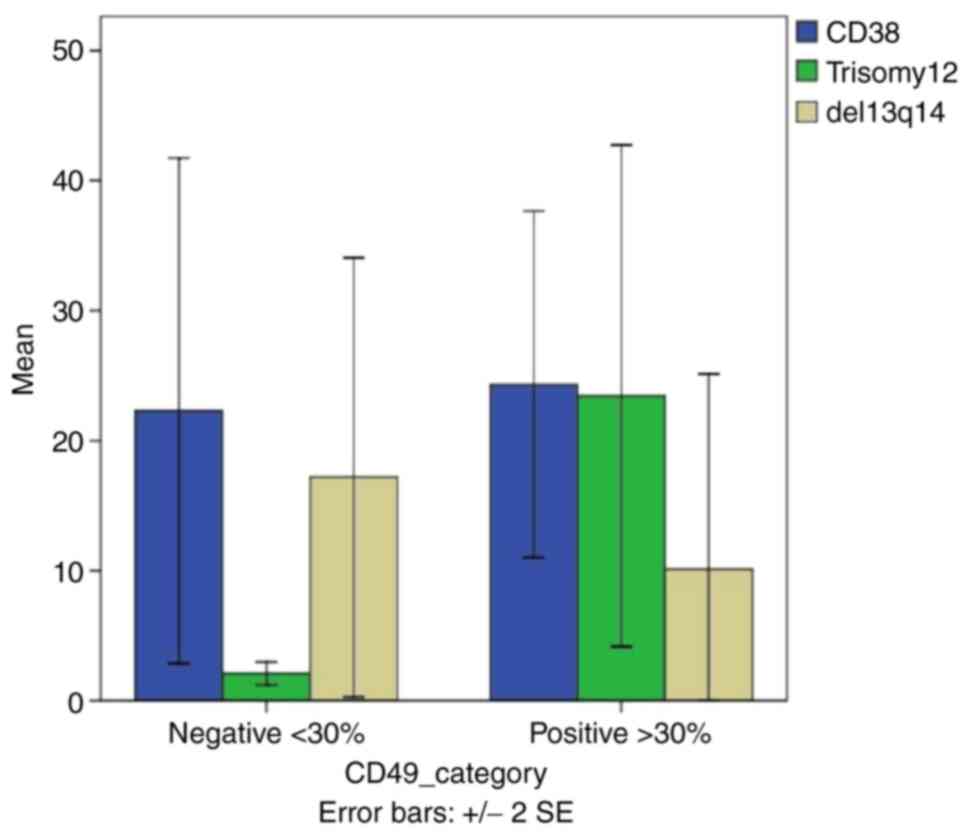Introduction
Chronic lymphocytic leukemia (CLL) is a clinically
heterogeneous disease, as evidenced by the fact that a proportion
of the patients have refractory disease and succumb within 2-3
years after the diagnosis, whereas others display an indolent
disease course without need for treatment and may survive for
decades (1). Due to this
heterogeneity, CLL is considered suitable as a disease model for
personalized medicine. In addition, malignant cells are easily
obtainable, and the patient characteristics, including clinical
parameters (e.g., age and comorbidities) and biological parameters
(e.g., genomic aberrations and mutations), are diverse. A large
number of cellular biomarkers have been found to be correlated with
the prognosis of CLL patients. Certain genetic lesions, such as
loss of function of the DNA-damage response by tumour protein P53
(TP53) gene (del17p), or ataxia-telangiectasia (ATM)
gene (del11q), particularly with respect to DNA-damaging
chemotherapy (e.g., fludarabine), have a highly negative prognostic
impact (2). Furthermore, markers
such as CD49d, CD38 and intracytoplasmic ZAP-70, which are not only
correlated with prognosis, but also with genetic aberrations, are
possibly involved in the mobilization and homing of CLL cells
(3,4). CD49d is the α4 subunit of the integrin
heterodimer α4β1. Its expression promotes microenvironment-mediated
proliferation of CLL cells and identifies a subgroup of CLL
patients who develop progressive disease (5,6). The
levels of soluble serum markers, such as thymidine kinase,
β2-microglobulin (B2M) and soluble CD23, are important predictors
of prognostic relevance in patients with CLL (7,8). With
the recent advent of new, more effective therapies, the known
survival predictors, which require continuous research to properly
stratify patients for treatment, are becoming obsolete (9). The aim of the present study was to
evaluate the most commonly used genetic and serological prognostic
markers known to have survival predictive value for identifying
high-risk CLL patients with a higher tumor burden to ensure
appropriate management, and to validate CD49d as a predictive
prognosticator in a sample of Egyptian patients with CLL.
Patients and methods
Subjects
A total of 81 Egyptian patients with CLL were
recruited from the National Cancer Institute and Kasr El-Aini
Hospital between December 2017 and October 2019. A total of 75
healthy subjects who were age- and sex-matched to the studied
patients were randomly recruited as the control group. All
participants provided informed verbal consent before being included
in the study, in accordance with the code of ethics of the World
Medical Association (Declaration of Helsinki) for experiments
involving human subjects. The study was approved by the Ethics
Committee of the National Research Center (registration no.
17-147). The diagnosis of CLL was based on the World Health
Organization classification of tumors of hematopoietic and lymphoid
tissues (10). Full history taking
and thorough clinical examination of the patients were performed to
evaluate the presence of pallor, petechiae, jaundice,
lymphadenopathy, splenomegaly or hepatomegaly. Treatment was
initiated in 58% of patients with disease-related symptoms,
advanced or progressive disease according to criteria described by
recent guidelines (11). At least
one of these criteria should be met: Evidence of progressive marrow
failure as manifested by the development or worsening of anemia
and/or thrombocytopenia; massive (≥6 cm below the left costal
margin) or progressive or symptomatic splenomegaly; massive nodes
(≥10 cm in longest diameter) or progressive or symptomatic
lymphadenopathy; progressive lymphocytosis with an increase of ≥50%
over a 2-month period, or lymphocyte doubling time <6 months;
autoimmune complications, including anemia or thrombocytopenia,
poorly responsive to corticosteroids; symptomatic or functional
extranodal involvement; disease-related symptoms including
unintentional weight loss ≥10% within the previous 6 months,
significant fatigue, fever (≥38.0˚C) for ≥2 or weeks without
evidence of infection, night sweats for ≥1 month without evidence
of infection.
Patients were evaluated clinically according to the
Binet and Rai staging systems (11)
regardless of treatment type or disease duration.
Sample collection
Peripheral blood samples (6 ml) were collected in
K2-EDTA, sodium heparin and plain blood collection tubes (Becton,
Dickinson and Company), in order to perform diagnostic and
prognostic evaluation of patients with CLL.
Flow cytometric analysis
Monoclonal antibodies for diagnostic and prognostic
evaluation (all from Beckman Coulter Immunotech) included: CD19-PC7
(cat. no. IM3628U); CD5-FITC (cat. no. IM0468U); CD10-PC5.5 (cat.
no. B16490); CD49d-FITC (cat. no. IM1404U); CD38-PE (cat. no.
IM2371U) and ZAP-70-PE (cat. no. B57658). Monoclonal antibodies
(all from Agilent Technologies, Inc.) included: CD20-FITC (cat. no.
F0799); CD79b-PE (cat. no. R7272); anti-kappa-FITC (cat. no.
F0434); and anti-lambda-PE light chains (cat. no. R0437).
Assessment of CD49d, CD38 and cytoplasmic ZAP-70
(cytoZAP-70) markers was performed using Beckman Coulter Navios
Flow Cytometer, as described by Chen et al (12). Labeled Mo Ab (20 µl) were dispensed
into appropriately labeled tubes, followed by the addition of 100
µl sample and incubation in the dark for 20 min. Three and half
milliliter Lysing reagent (3.5 ml) was added to each tube, inverted
once and kept for 5 min. Centrifugation was performed at 300 x g
for 3 min at room temperature, 3.5 ml PBS was added, and
centrifugation was repeated at 300 x g for 3 min. CD49d and CD38
were tested in two different tubes and were gated on
CD19+ B cells. IntraPrep Permeabilization Reagent (cat.
no. A07803; Beckman Coulter Immunotech) was used for cytoZAP-70
detection. Specific isotypic controls for FITC and PE-conjugated
monoclonal antibodies were used. The expression results were
reported as the percentage of
CD49d+/CD38+/cytoZAP-70+ cells
over the corresponding isotypic control within the gated
CD19+ B-cell population for each patient and control
subject.
Fluorescence in situ hybridization
(FISH)
FISH was performed for all fresh heparinized
peripheral blood samples obtained from the patients according to
the manufacturer's instructions using the Vysis CLL FISH Probe Kit
(cat. no. 04N02-021; Abbott Molecular) (13). The SpectrumGreen-labeled (LSI) ATM
probe specific for del11q22.3 contains the ATM gene, the
SpectrumOrange-labeled LSI-D13S319 probe is located at 13q14.3 and
the SpectrumOrange-labeled LSI TP53 probe is located at 17p13.1. In
addition, the SpectrumGreen-labeled CEP 12 probe is located at the
centromere of chromosome 12. A total of 200 interphase cells were
examined for each probe. The number of observed orange and green
signal patterns from each of two readers were added together to
generate the count for 200 nuclei for each specimen.
Normal/abnormal determination was made for each specimen by
comparing the number of nuclei with observed abnormal patterns per
200 scoreable nuclei to the normal determined cut-off value.
Cut-off points were determined by the main laboratory of Kasr
El-Aini Hospital from cytogenetically normal controls among
patients' relatives.
Serology
Serum samples from all recruited subjects were
quantitatively analyzed for sCD23 and B2M levels using the human
sCD23 ELISA kit (Invitrogen; Thermo Fisher Scientific, Inc.; Bender
MedSystems GmbH; cat no. BMS 227-2) and the B2M ELISA kit, ORGENTEC
Diagnostika GmbH; cat. no. ORG 5BM), according to the
manufacturer's protocols.
Statistical analysis
Data were coded and entered into the SPSS analysis
program (version 25; IBM Corp.). Data are presented as mean with
standard deviation, minimum and maximum for quantitative data and
as frequency (count) and relative frequency (percentage) for
categorical data. Comparisons between quantitative variables were
performed using the non-parametric Kruskal-Wallis and Mann-Whitney
U tests (14). Categorical data
were compared using the χ2 test. Fisher's exact test was
used instead when the expected frequency was <5(15). Correlations between quantitative
variables were assessed using Spearman's correlation coefficient.
P<0.05 was considered to indicate statistically significant
differences.
Results
Patient characteristics
The clinical data of patients with CLL are
summarized in Table I. A total of
32 patients (39.51%) had an indolent disease course during
follow-up, whereas 39 patients (48.14%) had progressive disease
with clinical symptoms. A total of 10 patients (12.35%) were newly
diagnosed at the time of recruitment. According to the Binet
staging system, 50.6% of the patients were stage C, 35.8% were
stage B and 13.6% were stage A at diagnosis. In the present study,
patients with CLL had clonal neoplastic cells with the
morphological characteristics of small mature B lymphocytes in the
peripheral blood. The hematological and serological findings of
patients with CLL and the age- and sex-matched controls are listed
in Table II. The wide range in
these parameters in the CLL group was expected due to the presence
of different categories of patients as regards disease stage and
therapeutic interventions. i) On flow cytometry, the patient
samples displayed 100% positive expression of CD19, 25 and 20, as
well as clonal restriction (λ-restricted, 37.04% and κ-restricted,
62.96% of the samples). ii) Prognostic workup: The expression
levels (%) of prognostic markers by flow cytometry are demonstrated
in Table III and Fig. 1. Representative flow cytometric dot
plots of different prognostic variables on CD19+ B-CLL
cases are shown in Fig. 2A-F. A
total of 54 patients with CLL (66.6%) exhibited genetic aberrations
using the FISH technique (Table IV
and Fig. 3A-D).
 | Table IClinical characteristics of patients
with CLL. |
Table I
Clinical characteristics of patients
with CLL.
|
Characteristics | Patients
(n=81) |
|---|
| Course of disease,
n (%) | |
|
Newly
diagnosed | 10 (12.35) |
|
Indolent | 32 (39.51) |
|
Aggressive | 39 (48.14) |
| Binet stage at
diagnosis, n (%) | |
|
A | 11 (13.6) |
|
B | 29 (35.8) |
|
C | 41 (50.6) |
| Rai stage at
diagnosis, n (%) | |
|
I and II
(intermediate risk) | 40 (49.4) |
|
III and IV
(high risk) | 41 (50.6) |
| Clinical findings,
n (%) | |
|
Lymphadenopathy | 59 (72.8) |
|
Splenomegaly | 56 (69.1) |
|
Hepatomegaly | 34 (41.9) |
| Light chain
subtype, n (%) | |
|
Lambda
(λ-restricted) | 30 (37.04) |
|
Kappa
(κ-restricted) | 51 (62.96) |
| Scheme of therapy
of 46 treated patients, n (%) | |
|
FC (purine
analogue-based) or FCR chemotherapy | 26 (55.3) |
|
Chemotherapy
other than FC, including CVP and CHOP | 16 (34.0) |
|
Targeted
therapya | 4 (8.5) |
 | Table IIHematological and serological
variables in patients with CLL and controls. |
Table II
Hematological and serological
variables in patients with CLL and controls.
| Variables | CLL patients
(n=81) | Controls
(n=75) | P-value |
|---|
| Sex (n),
male/female | 47/34 | 46/29 | 0.362 (NS) |
| Age (years) | 58.25±9.67 | 51.18±7.0 | 0.125 (NS) |
| Hemoglobin
(gm/dl) | 3.8-15.7
(10.8±2.5) | 12.0-18.6
(15.5±1.9) | 0.000a |
| Total leukocyte
count (x109/l) | 2.0-407.2
(78.1±105.9) | 4.0-10.0
(6.6±1.6) | 0.000a |
| Platelet count
(x109/l) | 30-412
(166.2±88.9) | 160-418
(262.9±55.1) | 0.000a |
| PB lymphocytes
(%) | 14-98
(61.4±28.6) | 15-60
(41.57±9.8) | 0.001a |
| Absolute lymphocyte
count (x109/l) | 0.6-371.7
(60.75±96.4) | 1.0-5.5
(2.6±0.8) | 0.000a |
| sCD23 (U/ml) | 13.8-20032
(1.443E3±96.0) | 9.9-95.0
(43.01±2.7) | 0.000a |
| B2M (µg/ml) | 2.0-17.8
(5.79±3.4) | 1.2-3.0
(2.6±0.49) | 0.000a |
 | Table IIIPrognostic variables by flow
cytometry in patients with CLL and controls. |
Table III
Prognostic variables by flow
cytometry in patients with CLL and controls.
| | Expression
levelsa in CLL
patients (n=81) | | Expression levels
in controls (n=75) | |
|---|
| Prognostic
markers | Range (%) | Mean ± SD (%) | Positive
expressionb in CLL
(%) | Range (%) | Mean ± SD (%) | P-value |
|---|
| CD49d | 0.1-94.0 | 15.7±22.7 | 25.9 | 0.5-3.9 | 2.2±1.1 | 0.000c |
| CD38 | 0.1-90 | 15.8±19.2 | 28.4 | 0.6-13.6 | 7.5±4.4 | 0.005c |
| ZAP70 | 0.1-62 | 6.0±13.3 | 8.6 | 0.0-2.9 | 0.8±1.0 | 0.004c |
 | Table IVPrognostic variables by FISH in
patients with CLL. |
Table IV
Prognostic variables by FISH in
patients with CLL.
| Prognostic
markers | Positive
expression, n (%) | Expression range
(%) |
Cut-offa
(%) |
|---|
| Trisomy 12 | 13(16) | 0.0-67.0 | 9 |
| del17p | 10 (12.3) | 0.0-81.0 | 9 |
| Del11q | 13(16) | 0.0-88.0 | 9 |
| Del13q14 | 18 (22.2) | 0.0-93.0 | 9 |
The patients were categorized according to the Binet
staging system, and a significant increase in the expression of
sCD23, CD49d and ZAP-70 was detected in group C (P=0.008, 0.034 and
0.017, respectively) when compared to both groups A and B, as shown
in Table V and Figs. 4 and 5. Elevated B2M (>3.5 µg/ml) was more
frequently detected in group B and C patients (91.7 and 97.1%,
respectively; P=0.004). In addition, patients under treatment with
advanced disease and aggressive course exhibited higher B2M levels
compared with those with an indolent course (P=0.025). The B2M
levels were significantly elevated in group C patients when
compared with group A patients (P=0.034).
 | Table VSignificant prognostic variables in
CLL patient groups according to the Binet staging system. |
Table V
Significant prognostic variables in
CLL patient groups according to the Binet staging system.
| Variables | Stage A (n=11) | Stage B (n=29) | Stage C (n=41) | P-value (stage C
vs. A and B) |
|---|
| sCD23 (U/ml) | 864.17±202.7 | 1.270±176.6 | 1.698±138.9 | 0.008b |
| CD49d (%) | 19.3±12.03 | 14.3±5.7 | 20.06±4.05 | 0.034a |
| ZAP-70 (%) | 0.5±0.2 | 1.1±0.4 | 8.7±3.0 | 0.048a |
Higher frequency of CD49d positivity was found in
patients with positive CD38 expression (P=0.027). CD49d was
considered positive when its level was >30% according to Bulian
et al (3). Higher incidence
of hepatomegaly and splenomegaly was detected among
CD49d+ patients (57.1 and 85.7% with P=0.049 and 0.016
respectively). Furthermore, CD49d+ patients exhibited
significantly higher CD38 levels (P=0.002; Table VI and Fig. 6). Additionally, CD49+
patients exhibited higher expression of trisomy 12 (P=0.015) and
lower expression of del13q14 (P=0.001), as shown in Table VI and Fig. 7.
 | Table VISignificant prognostic variables in
patients with CLL according to CD49d (CD49d+, n=21;
CD49d-, n=60) and trisomy 12 (trisomy 12+,
n=113; trisomy 12-, n=68) expression. |
Table VI
Significant prognostic variables in
patients with CLL according to CD49d (CD49d+, n=21;
CD49d-, n=60) and trisomy 12 (trisomy 12+,
n=113; trisomy 12-, n=68) expression.
| | Expression | |
|---|
| Variables | Positive | Negative | P-value |
|---|
| CD49d | | | |
|
Absolute
lymphocyte count (x109/l) | 75.9±30.9 | 47.1±13.6 | 0.022a |
|
CD38
(%) | 25.5±4.7 | 13.5±2.7 | 0.01a |
|
Trisomy 12
(%) | 21.6±7.03 | 4.06±1.3 | 0.015a |
|
Del13q14
(%) | 2.79±0.47 | 23.4±5.8 | 0.001b |
| Trisomy 12 | | | |
|
CD49d
(%) | 39.3±5.9 | 16.6±4.1 | 0.004b |
|
Del13q14
(%) | 2.9±0.46 | 20.8±4.6 | 0.000b |
Variations in the levels of CD38 and ZAP-70 in
relation to the different categories of sCD23 and CD49d are shown
in Fig. 8. Higher CD38 expression
was observed in patients with levels of sCD23 >95 U/ml and CD49d
positivity >30% (P=0.012).
In trisomy 12+ patients (n=13; 16% of
patients with CLL), CD49d positivity was more frequently observed
(75%; P=0.015), as was a higher mean level of CD49d (P=0.004) and
lower mean expression of del13q (P=0.000; Table VI and Fig. 9).
Patients positive for CD38 had a higher total
leukocyte count (TLC), absolute lymphocyte count (ALC) and sCD23
levels (P=0.038, 0.02 and 0.000, respectively).
Patients with both CD49d+ and B2M>3.5
µg/ml exhibited higher TLC (P=0.048), higher ALC (P=0.036), higher
expression of CD38 (P=0.002) and trisomy 12 (P=0.034), and lower
expression of del13q14 (P=0.002; Fig.
10).
In correlation studies, s-CD23 and CD49d were
positively correlated with CD38 (r=0.267 and 0.371; P=0.037 and
0.002, respectively); sCD23 was positively correlated with B2M
(r=0.344, P=0.003); and CD38 was positively correlated with the
presence of del11q (r=0.314, P=0.036).
Discussion
The present study investigated different clinical
and biological prognosticators in patients with CLL. Patients on
novel therapeutic agents were included in the study.
Patients were categorized according to the Binet
clinical staging system. sCD23, CD49d and ZAP-70 exhibited
significantly higher expression in group C when compared with
groups A and B. Therefore, the expression of these prognostic
markers in the early stages and throughout the disease management
may help identify progression. Popova et al (16) reported that flow cytometric markers
were negative in the early stages of CLL and underwent changes in
10-25% of cases with disease progression. Previously, Saka et
al (17) found that sCD23
determination at diagnosis and during the course of the disease may
help identify patients who rapidly progress to more advanced
stages.
Detection of CD49d by flow cytometry was considered
superior to CD38 and ZAP-70 in predicting overall survival
(18). In the present study, the
frequency of positive CD49d and CD38 cases was 25.9 and 28.4% of
the total number of cases, whereas that of ZAP-70 was 8.6%. Due to
the lower frequency of positive ZAP-70 expression among CLL
patients, the interpretation of the results was easier for CD49d
and CD38.
Patients with CLL were stratified according to their
CD49d levels to identify variations in different prognosticators.
In CD49d+ patients, higher incidence of hepatomegaly and
splenomegaly was observed, whereas higher expression of CD38, sCD23
and trisomy 12 and significantly lower expression of del13q14 were
detected by FISH. These findings were in agreement with those of
previous investigators who found that positive CD49d expression
>30% was associated with advanced clinical stage and aggressive
CLL course (3,18-20).
Recently, Tissino et al identified a bimodal expression of
CD49d with distinct clinicobiological characteristics in 20% of CLL
cases. They recommended that the pattern of CD49d expression should
also be considered to improve its prognostic impact in CLL
(21).
In the subgroup of CD38+ patients, higher
tumor burden with higher TLC, ALC and increased sCD23 levels were
detected. These associations were in agreement with previous
findings (22). Serological markers
have been considered as predictors of tumor burden in addition to
disease progression. In the present study, when patients were
stratified according to sCD23 expression levels, high levels were
associated with increased expression of CD38 and CD49d, indicating
its role in disease progression. In patients with high levels of
sCD23, higher CD38 expression was observed in the presence of
positive CD49d expression compared with patients negative for CD49d
expression. Patients with B2M levels >3.5 µg/ml and positive
CD49d expression exhibited increased tumor burden, higher
expression of CD38 and trisomy 12. These findings highlighted that
integrating both serological markers and CD49d may add to the
prognostic value of each marker alone. A number of researchers have
investigated the integration of prognostic markers into a combined
risk score due to discrepancies found in the same patient, with
some prognostic factors suggesting shorter time to first treatment
and overall survival compared with others (23-25).
Trisomy12+ CLL patients represent a
distinctive subset of patients with CLL who exhibit higher
expression of CD49d and lower expression of del13q14. The
association between trisomy 12 and CD49d expression was previously
explained (21). Trisomy
12+ CLL is characterized by high mutation frequency of
the NOTCH1 gene, and an association between higher CD49d
expression and the presence of NOTCH1 mutations through
nuclear factor-κB pathway involvement has also been reported
(26,27). In the future, the assessment of
TP53 aberrations, in the form of both gene mutations and
del17p, may become mandatory, as patients carrying such gene
disruptions are defined as high-risk. In addition, the analysis of
TP53 mutations can identify 30-40% of CLL patients who only
carry the gene mutations and may be missed by FISH. Cohen et
al proposed that TP53 aberrations, unmutated
IGHV, mutated NOTCH1 and CD49d expression are
powerful prognosticators and have predictive significance in CLL
before treatment initiation to guide therapeutic decisions
(28). IGHV mutational
status is a stable CLL prognostic marker and can be measured at any
time throughout the disease course. It may also help with the
selection of novel targeted therapies in unmutated cases. Further
studies are recommended on a larger scale to assess and integrate
the IGHV mutational status and TP53 mutations to
optimize patient stratification.
Expression of the sCD23, CD49d and ZAP-70 prognostic
markers in early-stage CLL and throughout the disease management
may help identify any progression to a more advanced stage. CD49d
is considered superior as a prognostic marker and CLL patients
positive for CD49d expression exhibited higher incidence of
hepatomegaly and splenomegaly, higher expression of CD38, sCD23 and
trisomy 12, and significantly lower expression of del13q14. CD38
expression was associated with higher tumor burden, higher TLC and
ALC, and increased sCD23 levels. CLL patients with high levels of
sCD23 exhibited higher CD38 expression in the presence of
CD49d-positive expression compared with CD49d-negative patients.
Patients with high B2M levels (>3.5 µg/ml) and CD49d-positive
expression exhibited increased tumor burden, higher expression of
CD38 and trisomy 12. Therefore, integrating serological markers and
CD49d expression by flow cytometry may add to the prognostic value
of each marker alone and help identify high-risk patients with a
higher tumor burden.
Acknowledgements
Not applicable.
Funding
The present study was supported by the Science, Technology and
Innovation Funding Authority (STDF), Egypt, through Targeted Health
call grant no. 22918.
Authors' contributions
HRMA and AHA contributed to the project preparation,
study design and submission for funding. HRMA, MHI and SHAEA were
responsible for the management of purchasing tasks and schedules.
MHI coordinated specimen collection and transport and implemented a
quality policy throughout the laboratory analysis workflow. MHI and
SHAEA contributed to serological analysis and tabulation of final
result. Patient selection and data collection were performed by
NMH, MES, RA, RR and OYAED. FISH was performed by MEY and HAAH.
Flow cytometric analysis was performed by RAO. NE contributed to
appropriate selection of CD markers and supervision of flow
cytometric procedures. Analysis of data and the first draft of the
manuscript were prepared by HRMA. All authors have read and
approved the final manuscript.
Ethics approval and consent to
participate
All participants provided verbal informed consent
prior to being included in the present study in accordance with the
code of ethics of the World Medical Association (Declaration of
Helsinki) for experiments on humans and the study was approved by
ethical committee of National Research Center, Egypt, (registration
no. 17-147).
Patient consent for publication
Not applicable.
Availability of data and materials
The datasets generated and/or analyzed in the
present study are available from the corresponding author upon
reasonable request.
Competing interests
The authors declare that they have no competing
interests.
References
|
1
|
Brachtl G, Piñón Hofbauer J, Greil R and
Hartmann TN: The pathogenic relevance of the prognostic markers
CD38 and CD49d in chronic lymphocytic leukemia. Ann Hematol.
93:361–374. 2014.PubMed/NCBI View Article : Google Scholar
|
|
2
|
Zenz T, Kröber A, Scherer K, Häbe S,
Bühler A, Benner A, Denzel T, Winkler D, Edelmann J, Schwänen C, et
al: Monoallelic TP53 inactivation is associated with poor prognosis
in chronic lymphocytic leukemia: Results from a detailed genetic
characterization with long-term follow-up. Blood. 112:3322–3329.
2008.PubMed/NCBI View Article : Google Scholar
|
|
3
|
Bulian P, Shanafelt TD, Fegan C, Zucchetto
A, Cro L, Nückel H, Baldini L, Kurtova AV, Ferrajoli A, Burger JA,
et al: CD49d is the strongest flow cytometry-based predictor of
overall survival in chronic lymphocytic leukemia. J Clin Oncol.
32:897–904. 2014.PubMed/NCBI View Article : Google Scholar
|
|
4
|
Zucchetto A, Caldana C, Benedetti D,
Tissino E, Rossi FM, Hutterer E, Pozzo F, Bomben R, Dal Bo M,
D'Arena G, et al: CD49d is overexpressed by trisomy 12 chronic
lymphocytic leukemia cells: Evidence for a methylation-dependent
regulation mechanism. Blood. 122:3317–3321. 2013.PubMed/NCBI View Article : Google Scholar
|
|
5
|
Zucchetto A, Vaisitti T, Benedetti D,
Tissino E, Bertagnolo V, Rossi D, Bomben R, Dal Bo M, Del Principe
MI, Gorgone A, et al: The CD49d/CD29 complex is physically and
functionally associated with CD38 in B-cell chronic lymphocytic
leukemia cells. Leukemia. 26:1301–1312. 2012.PubMed/NCBI View Article : Google Scholar
|
|
6
|
Uzay A, Toptas T, Kaygusuz I,
Ekşioğlu-Demiralp E, Tuglular TF and Bayık M: The prognostic value
of CD49d expression in Turkish patients with chronic lymphocytic
leukemia. Turk J Hematol. 29:354–360. 2012.
|
|
7
|
Mertens D and Stilgenbauer S: Prognostic
and predictive factors in patients with chronic lymphocytic
leukemia: Relevant in the era of novel treatment approaches? J Clin
Oncol. 32:869–872. 2014.PubMed/NCBI View Article : Google Scholar
|
|
8
|
Gattei V, Bulian P, Del Principe M,
Zucchetto A, Maurillo L, Buccisano F, Bomben R, Dal-Bo M, Luciano
F, Rossi FM, et al: Relevance of CD49d protein expression as
overall survival and progressive disease prognosticator in chronic
lymphocytic leukemia. Blood. 111:865–873. 2008.PubMed/NCBI View Article : Google Scholar
|
|
9
|
Jakšić B, Pejša V, Ostojić-Kolonić S,
Kardum-Skelin I, Bašić-Kinda S, Coha B, Gverić-Krečak V, Vrhovac R,
Jakšić O, Aurer I, et al: Guidelines for diagnosis and treatment of
chronic lymphocytic leukemia krohem B-Cll 2017. Acta Clin Croat.
57:190–215. 2018.PubMed/NCBI View Article : Google Scholar
|
|
10
|
Swerdlow SH, Campo E, Harris NL, Jaffe ES,
Pileri SA and Stein H (eds): World Health Organization
Classification of Tumours of Haematopoietic and Lymphoid Tissues.
4th edition, Volume 2. IARC Press, Lyon, France, 2008.
|
|
11
|
Hallek M, Cheson BD, Catovsky D,
Caligaris-Cappio F, Dighiero G, Döhner H, Hillmen P, Keating M,
Montserrat E, Chiorazzi N, et al: iwCLL guidelines for diagnosis,
indications for treatment, response assessment, and supportive
management of CLL. Blood. 131:2745–2760. 2018.PubMed/NCBI View Article : Google Scholar
|
|
12
|
Chen YH, Peterson LC, Dittmann D, Evens A,
Rosen S, Khoong A, Shankey TV, Forman M, Gupta R and Goolsby CL:
Comparative analysis of flow cytometric techniques in assessment of
ZAP-70 expression in relation to IgVH mutational status in chronic
lymphocytic leukemia. Am J Clin Pathol. 127:182–119.
2007.PubMed/NCBI View Article : Google Scholar
|
|
13
|
Dewald GW, Brockman SR, Paternoster SF,
Bone ND, O'Fallon JR, Allmer C, James CD, Jelinek DF, Tschumper RC,
Hanson CA, et al: Chromosome anomalies detected by interphase
fluorescence in situ hybridization: Correlation with significant
biological features of B-cell chronic lymphocytic leukaemia. Br J
Haematol. 121:287–295. 2003.PubMed/NCBI View Article : Google Scholar
|
|
14
|
Chan YH: Biostatistics 102: Quantitative
data-parametric and non-parametric tests. Singapore Med J.
44:391–396. 2003.PubMed/NCBI
|
|
15
|
Chan YH: Biostatistics 103: Qualitative
data-tests of independence. Singapore Med J. 44:498–503.
2003.PubMed/NCBI
|
|
16
|
Popova V, Blazheva S, Lukanov T, Naneva S
and Tzvetkov N: Study of the immunological markers CD49d and CD38
in early-stage B-Cll patients. J IMAB. 24:1883–1886. 2018.
|
|
17
|
Saka B, Aktan M, Sami U, Oner D, Sanem O
and Dinçol G: Prognostic importance of soluble CD23 in B-cell
chronic lymphocytic leukemia. Clin Lab Haematol. 28:30–35.
2006.PubMed/NCBI View Article : Google Scholar
|
|
18
|
Strati P, Parikh SA, Chaffee KG, Achenbach
SJ, Slager SL, Call TG, Ding W, Jelinek DF, Hanson CA, Kay NE and
Shanafelt TD: CD49d associates with nodal presentation and
subsequent development of lymphadenopathy in patients with chronic
lymphocytic leukaemia. Br J Haematol. 178:99–105. 2017.PubMed/NCBI View Article : Google Scholar
|
|
19
|
Baumann T, Delgado J, Santacruz R,
Martínez-Trillos A, Rozman M, Aymerich M, López C, Costa D, Carrió
A, Villamor N and Montserrat E: CD49d (ITGA4) expression is a
predictor of time to first treatment in patients with chronic
lymphocytic leukaemia and mutated IGHV status. Br J Haematol.
172:48–55. 2016.PubMed/NCBI View Article : Google Scholar
|
|
20
|
Fiorcari S, Benatti S, Zucchetto A,
Zucchini P, Gattei V, Luppi M, Marasca R and Maffei R:
Overexpression of CD49d in trisomy 12 chronic lymphocytic leukemia
patients is mediated by IRF4 through induction of IKAROS. Leukemia.
33:1278–1302. 2019.PubMed/NCBI View Article : Google Scholar
|
|
21
|
Tissino E, Pozzo F, Benedetti D, Caldana
C, Bittolo T, Rossi FM, Bomben R, Nanni P, Chivilò H, Cattarossi I,
et al: CD49d promotes disease progression in chronic lymphocytic
leukemia: New insights from CD49d bimodal expression. Blood.
135:1244–1254. 2020.PubMed/NCBI View Article : Google Scholar
|
|
22
|
Heintel D, Schwarzinger I,
Chizzali-Bonfadin C, Thalhammer R, Schwarzmeier J, Fritzer-Szekeres
M, Weltermann A, Simonitsch I, Lechner K and Jaeger U: Association
of CD38 antigen expression with other prognostic parameters in
early stages of chronic lymphocytic leukemia. Leuk Lymphoma.
42:1315–1321. 2001.PubMed/NCBI View Article : Google Scholar
|
|
23
|
Wierda WG, O'Brien S, Wang X, Faderl S,
Ferrajoli A, Do KA, Cortes J, Thomas D, Garcia-Manero G, Koller C,
et al: Prognostic nomogram and index for overall survival in
previously untreated patients with chronic lymphocytic leukemia.
Blood. 109:4679–4685. 2007.PubMed/NCBI View Article : Google Scholar
|
|
24
|
Rossi D, Rasi S, Spina V, Bruscaggin A,
Monti S, Ciardullo C, Deambrogi C, Khiabanian H, Serra R, Bertoni
F, et al: Integrated mutational and cytogenetic analysis identifies
new prognostic subgroups in chronic lymphocytic leukemia. Blood.
121:1403–1412. 2013.PubMed/NCBI View Article : Google Scholar
|
|
25
|
Pflug N, Bahlo J, Shanafelt TD, Eichhorst
BF, Bergmann MA, Elter T, Bauer K, Malchau G, Rabe KG, Stilgenbauer
S, et al: Development of a comprehensive prognostic index for
patients with chronic lymphocytic leukemia. Blood. 124:49–62.
2014.PubMed/NCBI View Article : Google Scholar
|
|
26
|
Benedetti D, Tissino E, Pozzo F, Bittolo
T, Caldana C, Perini C, Martorelli D, Bravin V, D'Agaro T, Rossi
FM, et al: NOTCH1 mutations are associated with high CD49d
expression in chronic lymphocytic leukemia: Link between the NOTCH1
and the NF-κB pathways. Leukemia. 32:654–662. 2018.PubMed/NCBI View Article : Google Scholar
|
|
27
|
Pozzo F, Bittolo T, Vendramini E, Bomben
R, Bulian P, Rossi FM, Zucchetto A, Tissino E, Degan M, D'Arena G,
et al: NOTCH1-mutated chronic lymphocytic leukemia cells are
characterized by a MYC-related overexpression of nucleophosmin 1
and ribosome-associated components. Leukemia. 31:2407–2415.
2017.PubMed/NCBI View Article : Google Scholar
|
|
28
|
Cohen JA, Bomben R, Pozzo F, Tissino E,
Härzschel A, Hartmann TN, Zucchetto A and Gattei V: An updated
perspective on current prognostic and predictive biomarkers in
chronic lymphocytic leukemia in the context of chemoimmunotherapy
and novel targeted therapy. Cancers (Basel). 12(894)2020.PubMed/NCBI View Article : Google Scholar
|















